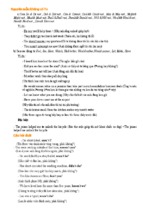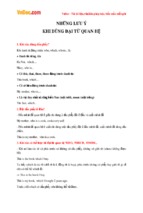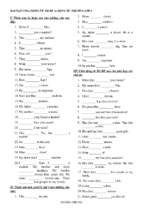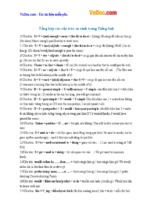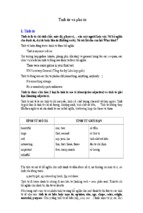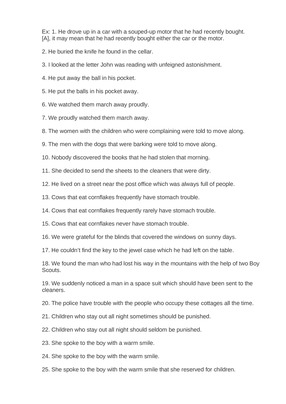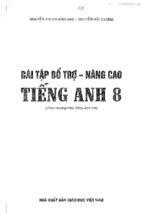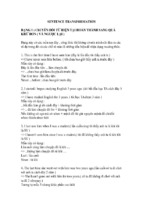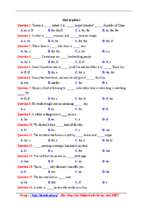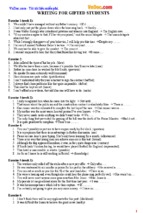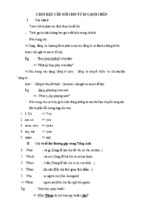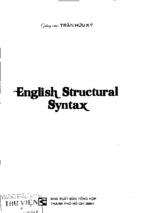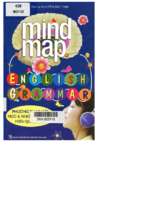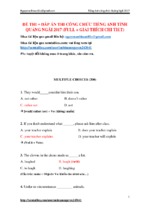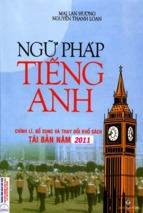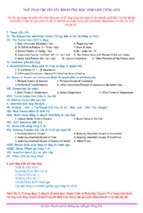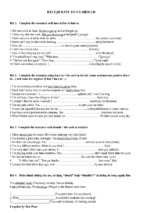Mantesh
8c John Anold
Mantesh
CONTENTS
Acknowledgements
Foreword v
iv
G ENERAL INTRODUCTION
vii
Introduction to Students ix
T eacher’s H andling Notes x
I N T R O D U C T O R Y S E C T IO N
S E C T IO N O N E
Choosing the R ight Language
M eeting People
Part O n e : Greetings and introductions
Part T w o : Personal interests
6
Part T h re e : Likes and dislikes
10
IN T E R S E C T IO N A
1
1
Moods and Feelings
Part O n e : Moods
18
Part T w o : Congratulations, regrets, reacting to news
S E C T IO N T W O
xvii
Plans and Choices
18
21
25
Part O n e : Social plans
25
Part Two: Invitations
27
Part Three A : Suggestions
32
Part Three B : Alternative suggestions
35
Part Four: Choice and preference
38
IN T E R S E C T IO N S
Part
Part
Part
Part
Apologising and Com plaining
O n e : Apologies and excuses 47
T w o : Apologising for changing future plans
T h re e : Criticism
51
F o u r: Complaints
54
S E C T IO N T H R E E
O pinionating
Part O n e : Opinions
57
Part T w o : Clarification
61
Part T h re e : Attack and response
64
Part F o u r: Suggesting courses of action
I N T E R S E C T IO N C
47
49
57
71
Linking Signals in Speech
81
Part O n e : Changing the subject, reinforcement, interrupting, balancing arguments
P art T w o : M aking a point more accurate, illustrating a point, M aking sure that you
have understood correctly
84
S E C T IO N F O U R
Part
Part
Part
Part
Help
81
87
One A : Advice
87
One B : Taking advice
90
Two A : Offers
93
Two B : Unwillingness and indifference
96
Booklet: Language Charts and Key (in back cover)
ill
ACKNOWLEDGEMENTS
There are a num ber of people who we would like to thank for their help in the
writing and revising of this book. In particular we would like to thank the
principal and teachers of Eurocentre Bournemouth, especially R ay Bell, Peter
Lucantoni and Roger Scott. We would like to record our gratitude as well to the
numerous students whose comments were invaluable. To the teachers and
friends who helped us with some of the recording sessions, m any thanks.
Throughout the writing of this course w£ have been helped im m easurably by
Leila Keane of the Longm an Resource and Development Unit, and without the
numerous typings and retypings by H eather Woodley and M ary Parsa this book
just would not have been possible.
T.P.H.H.
W.J.A.
Bournemouth and Southam pton
FOREW ORD
Like its com panion volume Advanced Writing Skills, the present book focusses on
the needs of the learner at the advanced level. At this level, gram m atical
accuracy alone is simply not enough for successful com m unication, particularly
in speech.
Advanced Speaking Skills takes as its keynote the concept of appropriateness - the
choice of language according to such factors as to whom one is speaking, the
moods of the speakers, etc. T he book thus opens up to the advanced learner the
opportunity of better reflecting his own attitudes and reacting to those of others.
T he accom panying tape, as well as providing intonation models, is designed to
help the learner become better aware of the nuances of attitude which are an
ever-present feature of communication.
T he book is designed so that - after completing the Introductory Section —the
individual parts can be taken in any order, with no need to work through the
whole book, or even whole sections, in a linear way. As each part is selfcontained moving from controlled through to free and individual production of
appropriate language the book can serve also as excellent supplem entary
m aterial to more traditional advanced course books.
As with previous Eurocentre publications - this being the eleventh in the series the m aterial has been thoroughly tested in the classroom, and we believe that
this book can add a valuable dimension of reality to the teaching and learning of
English by adults at the advanced level.
Erh. J. C. Waespi,
Director o f the Foundation
fo r European Language and
Education Centres
GEN ERAL IN T R O D U C T IO N
s p e a k i n g s k i l l s , like its com panion course a d v a n c e d w r i t i n g
is concerned with w hat we w ant to do with the language; for example, to
advise. Giving Advice is a languagefunction. T here are various ways in which we
can give advice in English, e.g. I f I wereyou, I ’d . . ., Personally, I think your best
course would be to . . . etc. T he way we choose to say something will depend on our
attitude to the person or people who we are speaking to. A m ain concern of this
course is appropriateness, that is the choice of a way of saying something which
expresses our attitude appropriately, i.e. showing th at we are being <(polite>,
<[informal)>, <[tentative]> and so on.
a d v a n ced
skills,
T he course
T he course is designed for students who have either passed the Cam bridge First
Certificate exam ination or successfully completed an equivalent course of study.
By the end of the course, successful students should be able to use the language
presented to express themselves appropriately according to the social (or other)
situation they are in. Such students will be in a position to take the O ral paper of
the Cam bridge Certificate of Proficiency after further training in the specific
techniques necessary for that p art of the examination.
CO N TEN TS OF TH E COU RSE
T he course contains:
An Introductory Section
Four Sections
T hree Intersections
A booklet containing Language Charts and a Key
An Accom panying T ape or Cassette
SECTIONS
In addition to the Introductory Section, there are four m ajor Sections in this
course. Each Section concerns itself with a large area of language activity. Each
Section is divided into Parts, which look at a more specific language area. For
example, Section Four is entitled h e l p , because it concerns the language we use
to help others with problems, or to ask for help when we have problems
ourselves. T he two parts of Section Four are (1) Asking fo r and Giving Advice and
(2) Offers. In P art O ne we look at the language we use when advice is needed,
and in Part Two we look at the language we use when we wish to offer to help
someone. W hen we look at Offers we see th at there is a Language Interaction.
We can expect that if someone states that they have a problem we may Offer
Vll
Help or Show Willingness. T he person with a problem will then probably either
Accept our Offer, Ask us to Do Something or Reject our Offer. We can represent these
possible interactions in the following w a y :
We can say th at it is likely that a conversation will follow one of these lines.
INTERSECTIONS
T here are three Intersections in the course, whose design differs, in some
respects, from that of the Sections. We have seen (above) that Sections are
concerned with situations in which we can predict w hat lines a conversation is
likely to follow. As it is often very difficult to do that with language, the
Intersections look at areas which do not necessarily form the basis for
predictable language interactions —for example, it is very difficult to predict
w hat will happen when someone wishes to interrupt. Nevertheless, the language
in the Intersections is grouped functionally so that Intersection C, for example,
is called l i n k i n g s i g n a l s i n s p e e c h and deals with the functions of
Interrupting, Changing the Subject, etc.
LA YO UT OF TH E COU RSE
in t r o d u c t o r y sectio n
This presents the concepts of attitude and appropriateness, introduces a cast of
characters, and explains the form at of the book.
SECTIONS AND IN T E RSE CTIO N S
Each P art of each Section or Intersection will contain some or all of the
following:
a) Language Presentation, which includes:
A Diagram m atic Representation of the Language Interaction
M odel Conversations
Language Charts (in the booklet in the back cover)
b) Controlled Practice, which includes:
M anipulation Drills
Cast Conversations
Faded Dialogues
viii
c) Situational Practice, which includes:
Interaction W riting
Practice Situations
Free Practice
Dialogue W riting
In addition each Section contains:
d) Role Simulation
e) Extensive Listening
T H E T A P E OR CASSETTE
This contains:
Model Conversations
M anipulation Drills
Extensive Listening
D E S IG N O F T H E C O U R S E
T he course is designed in such a way that it is not necessary to move through the
book in a linear way, that is from the beginning to the end. Each Section and
Intersection is divided into Parts which practise certain small areas of language.
Each P art m ay therefore be studied at any point during a course, and the class
need not necessarily follow the sequence in the book. It must be emphasised,
however, that the Parts of a Section or Intersection complem ent each other.
Each Role Simulation, and the Extensive Listening, is based upon the language
from the whole Section of which they are a part.
The following publications have been particularly useful in the preparation of
this bo o k :
Leech, G. and Svartvik, J ., A Communicative Grammar o f English, Longm an 1975.
Wilkins, D. A., Linguistics in Language Teaching, Edw ard Arnold, 1972.
Wilkins, D. A., Notional Syllabuses, Oxford University Press 1975.
V an Ek, J ., The Threshold Level, Council for C ultural Co-operation, Council of
Europe 1975.
Introduction to students
This book is designed for students who have passed the Cam bridge First
Certificate exam ination or who have done a course to about the same level. T he
aim of the book is to help you to converse fluently and appropriately in English.
You should know w hat kind of language to use in certain situations. Do you use
the same language with a friend as you do with a complete stranger? Probably
not, and it is the aim of this book to show you when to use certain types of
language, and how to use them.
It is absolutely essential thatyou should study the Introductory Section (pages xvii—xxii)
before starting the course. It explains how we choose the language we use, and it
ix
also explains how the course works. If you do not understand anything in the
Introductory Section you should ask your teacher.
S E C T IO N S A N D IN T E R S E C T IO N S
The course is divided into four m ain Sections and three Intersections. Each
Section and Intersection contains more than one Part. Each Part contains:
Language Presentation - designed to show you how the language works (in a
diagram and in a M odel Conversation) and the appropriate language to use
(in a chart which appears in the booklet in the back cover).
Controlled Practice - designed to give you practice in the language from the c h a rt:
the practice here is very controlled so that you can become fluent in using the
forms (the gram m ar) of the language.
Situational Practice - designed to give you less controlled practice. Here you will
be asked to imagine yourself in various situations, and you will have to choose
the most appropriate language to use.
In addition, each Section contains:
Role Simulation - designed to give you further practice in the language from the
Section. You will be asked to take part, with the rest of the class, in a realistic
situation in which you will need to use the language that you have studied.
Extensive Listening - designed to enable you to hear conversations in which
English people are using the same area of language that has been covered in
the Section.
T H E TAPE O R CASSETTE
This contains:
Model Conversations - recordings of the conversations at the beginning of each
P art of each Section or Intersection.
Manipulation Drills - giving you the correct answers to the M anipulation Drills
in each Part. These answers can be used as models for pronunciation practice.
Extensive Listening —designed to give you examples of English people using the
language which you are studying.
T eacher’s handling notes
I N T R O D U C T IO N
T he m ain aims of this book are to increase the students’ oral communicative
ability, and to enable the students to choose ways of saying things which are
appropriate to different situations. T he m ajority of the practice is designed to
enable the students to learn how to be more, or less, polite in using the
functional language they are studying. It isfor this reason that the Introductory Section
(pages xvii-xxii) is so important, since it sets out not only the design o f the course, but also
the different categories o f language that are used in the course. O nce the students have
clearly grasped the concept of Attitude they will be able to proceed with the m ain
body of the course.
T he language and the language functions in the course will not seem unfam iliar
to m any of the students for whom this course is designed. It should be impressed
on them , therefore, that the aim of the course is for them to be able to produce
the language accurately and fluently, and th at they should have the ability to
vary the ways they perform a certain language function appropriately according
to the situation they find themselves in.
As has already been stated in the G eneral Introduction, the course is designed in
such a way as to give the teacher flexibility: it is not designed so that a teacher
necessarily has to start at Section O ne and end at Section Four. Indeed this type
of linear approach might well be counter-productive. T he individual Parts of
the Sections and Intersections can be studied in isolation. In other words, where
a class is non-intensive, it would be possible to complete the m aterial of one Part
in two and a half hours of a week. Since each Part ends with some form of Free
Practice, the completion of a Part would be a realistic objective for both teacher
and students.
H A N D L IN G N O T E S
(Teachers need not necessarily follow the order in which the various exercises
and practices occur. A diagram showing two possible schemes of presentation
and practice occurs at the end of these H andling Notes on pages xiv-xv.)
[a ]
la n g u a g e
pr e se n t a t io n
1 Interactions
Students’ attention should be draw n to the different directions in which a
conversation could go.
2 Model Conversations (on tape or cassette, or from the book)
Students should be asked to identify the language th at the characters use to
perform their p art of the language interaction (see 1 above).
3 Language Items
T he students should look at the charts (in the booklet in the back cover),
and the teacher should point out any areas of particular gram m atical
difficulty, for example in the question couldyou give me some advice about. . .
students frequently omit the word about. Special attention should therefore
be draw n to it. Heavily stressed words should also be pointed out (they will
be underlined), for example Fm not particularly keen on . . .
[b]
c o n t r o l l e d
pr a c tic e
1 Manipulation Drills
These should be done with the whole class. T he students should be able to
see the Charts, and the teacher should follow the usual techniques of Choral
xi
and/or Individual Repetition. Teachers should not be afraid to do the same
sentence more than once. It is at this stage that the teacher can concentrate
especially on the correctness of the form and the stress and intonation.
Teachers fortunate enough to have class tape recorders will find the
accompanying tape or cassette particularly useful here. O n the tape, there
is a pause before the correct m odel is given so that the M anipulation Drills
can be used as laboratory m aterial, or the teacher can conduct these drills
with the use of a tape recorder.
2 Cast Conversations
This exercise is especially useful as preparatory homework, but it can also
be used as pair work or with the whole class. Here the students have to
make decisions about the Attitude the speakers would take up and the
teacher should ask them to justify their choice, since in some cases it will
not be possible to say that one of the characters could use only, for example,
(tentative') language.
3 Faded Dialogues (Intersections only)
It is suggested that these can be done with the whole class.
[c] S I T U A T I O N A L P R A C T I C E
1 Interaction Writing
This exercise has been designed with pair work (or small-group work) in
mind. Students can work through the items, and then they can write one or
more of the short dialogues. At this stage they should be encouraged to
operate without reference to the Charts unless they really have to. They
should make sure th at they are expressing the appropriate Attitude. The
dialogues can be acted out in class. This exercise could also be set as a small
homework task.
2 Practice Situations
These have been designed for pair work or group work, but can equally
well be used with the whole class.
3 Dialogue Writing
This exercise has been designed especially for homework, since dialogue
writing of this length m ay require a lot of time if done in the classroom. A
useful m arking technique is to place a tick in the m argin of the student’s
homework when he uses language from the Part or the Section
appropriately.
4 Situational Responses (Intersections only)
It is suggested that these should be done with the whole class. W here
students are hoping, eventually, to attem pt the Cambridge Certificate of
Proficiency it can be pointed out that these Situational Responses are very
similar to those occurring in that examination.
5 Free Practice
T he Free Practice phases in the course take a variety of different forms.
T hey m ay involve the whole class or groups of students. H ere (and in the
xii
Role Simulations) it will be necessary for the students to prepare, and be
prepared, for the practice. It is suggested th at the teacher’s usual insistence
on correctness m ight be waived here, since the objective is for the student to
produce the language from the P art freely. Interruption, in the form of
correction, might impede this autonom y. T here will, however, be some
cases where a teacher will feel obliged to interrupt, but this should be the
exception rather than the rule. In some cases it m ay be necessary for the
teacher to be a discussion leader, or at least to prom pt the students. A list of
mistakes can be m ade by the teacher and this list can be referred to after
the Free Practice phase is finished.
6 Flashback Dialogues (Intersections only)
These are best used as pair work or as homework. Students might be
encouraged to act out the dialogues before or after writing them.
[d ]
r o l e sim u la tio n
T he Role Simulations have two m ain purposes: to give the opportunity for
students to practise the language which they have studied in the course and,
in a wider context, to provide enjoyable general language practice. In the
unreal world of the classroom, it is not in fact unrealistic to ask students to
take roles which are probably outside their personal experience. T he roles
given are defined in such a way th at each student knows w hat he or she will
have to contribute to the activity. At no time are students required to do
things which dem and really specialised knowledge. Willingness to participate
and contribute (and not an ability to act) is the m ain quality required of
students in the Role Simulations.
It will be the teacher’s responsibility to prepare the class for the Role
Simulation. He should explain this situation thoroughly to the students and
be sure th at they understand it fully before he assigns roles. In most cases the
students should prepare, either in or outside the class. For example in Section
Three, at the end of P art T hree, there is a Role Sim ulation in which an
im aginary town council is trying to decide between three rival plans. The
teacher should explain the situation and then put the students into groups
favouring one plan or another. In the case of those whose roles commit them
to a particular plan, the group should plan argum ents in favour of their plan
and against the others. In the case of those who are, as yet, uncom m itted, the
group should prepare argum ents against the three plans and/or argum ents in
favour of the plan they support and/or argum ents in favour of a plan they
themselves dream up. W hen it comes to the actual Role Simulation, the
teacher m ay have to take the part of the chairm an, so that he or she can be in
control of the situation and can help to ensure th at all the students are given a
chance to join in. However, if a student can perform this role successfully, all
the better. T he Role Simulations can be particularly useful and m otivating if
they are recorded, either with a video or with a tape recorder. In this way the
students can see how well they perform and w hat progress they are making.
xiii
[e ]
ex ten siv e
listen in g
The purpose of these listening passages is to enable students to hear the
language they have studied in the wider context of authentic English - that is
in conversations in which real English people are not restricted in any way in
their use of the language. It is suggested that these passages are particularly
useful as back-up and revision material.
For each Extensive Listening phase there are three types of comprehension
question: General Comprehension simply ensures that the students have
understood w hat has been said ; Language in Context picks out vocabulary,
phrases and idioms which have wide application. Reading between the Lines (a
euphemism for inferring feelings and attitudes) asks the students to make
inferences about the speakers’ attitudes. These True/False questions are
designed as discussion points; more im portant than whether a student thinks
the answer is true or false are his or her reasons for so thinking. Often these
reasons will depend on the items of language that are used, so that the
questions focus attention, yet again, on the language from the Section to
which the Listening Phase relates. These Listening Phases are designed for
classroom use, but they can equally well be used in the Language Laboratory,
and, since there are suggested answers to all the questions in the Key, they
can be used by the student working alone.
t h e t a pe
or cassette
In addition to the Extensive Listening, the taped m aterial contains the Model
Conversations and the M anipulation Drills. T he Model Conversations can be
used either to introduce the Function that is to be studied, or to exemplify the
Interactions that occur at the beginning of each Part.
T he M anipulation Drills provide correct models of the language exponents in
the Charts, and as such can be used either by the teacher or by the class as
pronunciation models or as laboratory m aterial (see [ b ] 1) .
SCHEMES FO R PR E SE N T A T IO N AND P R A C T IC E
T he following diagrams show two different models for the order of the various
exercises and practices.
Interactions
Model Conversations
Interaction Writing
Cast Conversations
Practice Situations
-&>
Language Items
<3- Manipulation Drills
-fc>
Free Practice
♦
Extensive Listening* 43-
Role Simulation
J
* T h e Extensive Listening taped m aterial with its accom panying exercises has been designed for use when
a Section has been studied by the class. H owever, some teachers m ay prefer to preface work on a Section with
some or all o f an Extensive Listening phase.
xiv
b)
I f the students show a fam iliarity with the gram m atical forms of the
language exponents the following order might be adopted by the teach er:
Obviously it will be up to the teacher to decide how m any of the exercises to
do, and in w hat order. Sometimes, for example, it m ight be interesting to
study the Cast Conversations and then go back to the M anipulation Drills, or
even to study the Cast Conversations and then go back to the Language
Presentation phase. Generally, however, the Role Simulations and Dialogue
W riting phases should occur at the end of a teaching unit.
xv
I N T R O D U C T O R Y S E C T IO N
C H O O S IN G
T H E R IG H T L A N G U A G E
A ttitude
In English, as in most other languages, we can say the same thing in a num ber
of ways.
The language we choose will depend on some or all of the following things:
T he relationship we have with the people we are talking to ;
(e.g. w hether they are closefriends, strangers, people in authority, etc.)
T he situation we are i n ;
(at afriend’s party, at an official reception, etc.)
T he mood we are in ;
(angry, happy, nervous, etc.)
T he mood of the people we are talking to ;
( We will probably be especially careful when talking to afriend who is in a bad mood.)
W hat we are talking a b o u t;
( We will be more careful in our choice o f words i f we want to complain to afriend about
hisIher behaviour than we would i f we were offering him Iher a drink.)
It is im portant to choose appropriate ways of saying things according to the
situation we are in. In m any situations it will be appropriate to use and say I ’m not sure i f I ’d agree withyou.
<(D irect} : <(Direct) language is the opposite of <(tentative} language; it gives the
impression that the speaker is very sure. This impression is appropriate if, for
example, we w ant to agree with someone, but it can sound presumptuous and
rude in a great m any situations and would be inappropriate in such situations
(e.g. inviting a superior to a party).
xvii
(P o lite ) : We use polite) language when we w ant to sound particularly (polite'}
without being (tentative).
( Formal >:
You say
A friend of yours has just phoned to say that he/she is coming to see you
tomorrow evening. This is not very convenient for you, so although you
know your friend will be disappointed, you ask him /her to come the day
after.
a) ( normal]>
b) (polite)
c) ( tentative)
language
You use
d) (ratherformal)
e) ( direct)
f ) ( direct and informal)
You say
4 You are the personal secretary to the m anager of a large company.
Someone has just phoned to speak to the m anager, but he is in a meeting.
You ask the caller to phone back in an hour.
a)
b)
c)
You use
d)
^
f)
You say
5 You are in a
you one.
a)
b)
c)
You use
d)
e)
f)
You say
( normal)
(polite)
( tentative)
(direct)
(direct and informal)
restaurant and there is no ashtray. You ask the waiter to get
(normal)
(polite)
(tentative)
(ratherformal)
(direct)
(direct and informal)
language
xix
T H E C A ST
Throughout the course you will meet the following six people. You should pay
special attention to their characters, social position, and the social situations in
which they find themselves since these will influence w hat language they use
and how other people talk to them.
T hroughout the course there will be practices called c a s t c o n v e r s a t i o n s in
which you will be asked to select the right kind of language (normal, tentative,
direct> etc. for the characters to use.
This is The Cast.
D O N A L D C R O M E R Age 53
T he eldest of five children, he went to
gram m ar school and university and
later became a solicitor. H e spends a
lot of time in meetings with his
clients, who are.often businessmen.
He has fairly traditional views and is
by nature a quiet person.
N A N C Y C R O M E R Age 50
D onald’s wife and the daughter of an
arm y officer. She met Donald when
she was twenty-two. They have two
sons and a daughter; the elder son is
an accountant and the other two are
at university. Since her m arriage Nancy
has devoted herself to her family.
She is a rather nervous person.
SU SA N G R E Y Age 21
Susan lives in the flat above Donald
and Nancy Cromer. After leaving
school at the age of 16 she joined the
local newspaper as a secretary. She
was soon helping on the wom en’s
page, and last year she became a
news reporter. She has a very
outgoing personality.
xx
C A R O L A N D E R S O N Age 24
Carol shares a flat with Susan and is
a teacher at the local secondary
school. She is a rather serious person,
who takes a lot of interest in her
students.
D A V ID S T U A R T Age 23
David is C arol’s boyfriend. He is a
rather unsuccessful professional
musician who writes and sings his
own songs. He has m ade one L.P. but
is not well known yet. He is rather
shy.
G R A H A M W IL L IA M S Age 28
G raham is a barm an at the ‘Hope &
A nchor’, a large pub which has a folk
club every Thursday evening. He left
school when he was fifteen and has
done a variety of jobs since then. He
has become friendly with David
Stuart, who sometimes plays in the
‘H ope & A nchor’. H e is by nature
rather aggressive.
xxi
3 C A S T C O N V E R S A T IO N S
OBJECTIVE
T o select appropriate language.
Use appropriate language from C hart 1 ‘Asking Someone to Do Som ething’ in
the following situations, and be prepared to justify your answers.
a) Susan has ordered two books from the bookshop which is near Carol’s
school. She asks Carol to pick them up on her way home from work.
Susan says________________________________________________________
b) Donald Cromer phones one of his colleagues to ask him to come to a
meeting in his office at 11.00 the next day.
Donald says_______________________________________________________
c) David Stuart did not have time to go to the bank today. In the pub he asks
G raham Williams to lend him £5.00.
David says________________________________________________________
d) Susan Grey and Carol Anderson are listening to some records. In the flat
below, Nancy Cromer can hear the gramophone, and because she has got
a headache, she goes to the girls’ flat and asks them to turn the music
down.
Nancy says________________________________________________________
e) Carol Anderson is writing the end of term science exam, but she is very
busy so she needs some help. She asks the Principal of the school if she will
help her, even though Carol knows she is very busy at the moment.
Carol says_________________________________________________________
f ) At the newspaper office Susan’s secretary is going to the cafe across the
road to get some sandwiches. Susan wants a ham sandwich and a cup of
coffee and calls out to her secretary just as she is leaving the office.
Susan says________________________________________________________
/MEETING
PEOPLE
Section 1
PA R T ONE
a
|
G R E E T IN G S A N D I N T R O D U C T I O N S
Language presentation
1 I N T E R A C T IO N S
2 M O D E L C O N V E R S A T IO N S ®
*
a) Susan Grey is just going into the local town hall, when she meets
D onald Cromer.
1
- Xem thêm -

